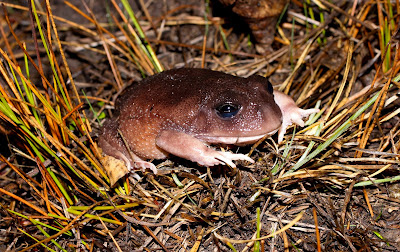I always get excited with the first Autumn rains. For us wildlife freaks, it signals a short window where you can get out to hear and look for Heleioporus frogs. These frogs are awesome. Firstly who doesn't love frogs? And these frogs have a unique biology, are big and look fantastic. In researching for this blog, I actually learnt some fascinating information regarding their breeding cycle. I knew that these species bred by excavating a burrow in which they lay their eggs in to foamy nest (up to 700 eggs per nest!), but am surprised to find out metamorphosis of the tadpoles ranges from 10 days right up until a couple of months in to Spring.
.JPG) |
| Essential frogging equipment. LED lenser H7 head torch, Cannon DSLR and macro lens, and field guide to the Frogs of WA. |
There are six species in total in Australia, five of these species are found within the south west of WA. They are unique because they spend the majority of their lives burrowed in to the ground. Come the Autumn rains they spring back to life to begin advertising calling for breeding. Their calls are varied, everything from soft hoots, to moaning, to 80's Atari video game style whoop-whoop-whoop-whoop-whoop. They have slightly varied habitats, but if you know where to look, you can find all five species in the same location.
 |
| A typical sandy burrow seen during Autumn, made by a Heleioporus species frog. |
In alphabetical order, the first species is Heleioporus albopunctatus - Western Spotted Frog. This was the last species of the Heleioporus species i needed to see, so was relieved to see a couple just recently. These guys have quite a large distribution, ranging from Kalbarri south through the wheatbelt and south west down to Jerramungup. Easily diagnosed from other species from its white spots.
 |
| A bit of albopunc action, this species is easily diagnosed from others with it's obvious white spots. |
The next species is easily the rock star,
Heleioporus barycragus - Hooting Frog, or to us, just Barry. This frog is as striking in its yellow colour pattern as it is by its size. These frogs are ridiculously big, giants of things, apparently not uncommonly mistaken as a Cane Toad due to their large size. They are also the most restricted and potentially most threatened. Restricted largely to the Darling Range from Bullsbrook to Dryandra, within small streams. Surprisingly, their call is not representative of their size, consisting of a soft hoot. Almost ridiculously, I have a resident population within 100 m of my house, and have even had one in my front yard.
.jpg) |
| Here's a backyard bary. Based on the lean condition of this individual, i'd say they just popped out of their burrow and straight in to my yard. I couldn't help but provide a tasty cricket for photo payment. |
 |
| Here's a very large male bary, the size in the hand gives some context as to how big they really are. |
The third species is the most commonly encountered,
Heleioporus eyrei - Moaning Frog. If you rock up to any wetland or creek around Perth or the south west in Autumn, chances are you will hear these guys moaning away. Their call is a drawn out, rising moan. Apparently the species name is named after Edward John Eyre, who was the first (and probably the only) white person to walk across the nullabor.
.jpg) |
| The Moaning Frog is the most common around Perth, i have them just down at my local creek. |
Next is
Heleioporus inornatus - Whooping Frog. This species is probably the plainest in terms of appearance, being a uniform light browny smudge, but makes up for it with its loud "whoop... whooop .... whoop" call. They are less restricted to creeklines then some of the other species, and can be found in any natural depressions of sandy soil.
.jpg) |
| This Whooping Frog remained sleepy and despite lots of poking never wanted to give me a photogenic pose, so here's an average photo. |
Last but not least is
Heleioporus psammophilus - Sand Frog. An unimaginative species name, and as you have guessed this species is found in sandy and clayey areas in natural depressions. The key characteristic for this species is its 80's techno video game style call. For those that haven't heard this species, I highly recommend you head up in to the Perth hills during Autumn and listen out for constant the whop-whop-whop-whop-whop-whop,
 |
| Here's a Sand Frog semi-visible from its sandy burrow. Often frogs will be calling from deep within their burrows, so you will hear them but not be able to see them. |
.jpg) |
| And a surface version. |
Here's a sample of the calls you might hear from Heleioporus frogs. You should be able to figure out the species, the photos give it away. You might need head phones to hear the two quieter species ;)
.JPG)



.jpg)

.jpg)
.jpg)
.jpg)
No comments:
Post a Comment